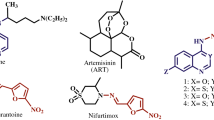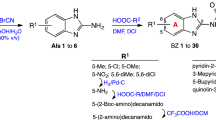Abstract
In vivo antimalarial screening of nine nonlinear phenoxazine compounds was carried out on the blood stages of Plasmodium berghei using standard methods. The activities of the compounds were compared with that of quinine as a standard antimalarial drug. LD50 and histopathological studies were also done. Molecular docking studies were carried out on four different protein targets of Plasmodium spp. The effects of these compounds on the hematological parameters (Hemoglobin, Hb; packed cell volume, PCV; white blood cells, WBC; and red blood cells, RBC) were also evaluated. The in vivo antimalarial studies showed that all the synthesized compounds had significant parasitaemia load reduction (89.00–94.05%) at 200 mg/ml when compared with the control, with (2-aminophenoxyl)benzo[a]phenoxazin-5-one 3b showing the highest activity. There was no significant difference in the activities of these compounds compared with the standard drug used (96%). The LD50 was found to be ≥5000 mg/kg. Histopathological studies showed a significant restoration of the liver intoxicated with malaria parasite after 5 days. The hematological analysis showed normal values for Hb, PCV, WBC, and RBC in the course of the treatment. The compounds showed more binding affinities for the P. falciparum receptors than the standard drug. The nine synthesized nonliner phenoxazine compounds had significant antimalarial activities and did not significantly affect the hematological parameters. They showed strong binding affinity to the parasite receptors. Hence, they are good candidates for antimalarial drugs. More preclinical investigations are needed.










Similar content being viewed by others
Abbreviations
- 1CET:
-
lactate dehydrogenase
- 3QS1:
-
plasmepsin I
- 1LS5:
-
plasmepsin II
- 1SME:
-
plasmepsin IV
- STD:
-
standard drug
- MW:
-
molecular weight
- NoRB:
-
number of rotatable bonds
- logP:
-
partition coefficient
- HBA:
-
number of hydrogen bond acceptors
- HBD:
-
number of hydrogen bond donors
- nViolation:
-
number of violation
- TPSA:
-
total polar surface area
- NC:
-
normal control
- NP:
-
no parasitaemia
- UG:
-
untreated group
- Hb:
-
Hemoglobin
- PCV:
-
packed cell volume
- RBC:
-
red blood cell
- WBC:
-
white blood cell
References
Banerjee R, Liu J, Beatty W, Pelosof L, Klemba M, Goldberg DE (2002) Four plasmepsins are active in the Plasmodium falciparum food vacuole, including a protease with an active-site histidine. Proc Natl Acad Sci USA 99:990–995
Barness EC, Bezerra-Gomez P, Nett M, Dandamycin HC, Chandrananimycin E (2015) Benzoxazines from streptomycesgriseus. J Antibiot 68:463
Binkowski TA, Naghibzadeg S, Liang J (2003) CASTp computed atlas of surface topography of proteins. Nucleic Acids Res 31:3352–3355
Chaikuad A, Fairweather V, Conners R, Joseph-Horne T, Turgut-Balik D, Brady RL (2005) Structure of lactate dehydrogenase from Plasmodium vivax: complexes with NADH and APADH. Biochemistry 44:16221–16228
David AF, Philip JR, Simon LC, Reto B, Solomon N (2004) Nat Rev 3:509–520
Dacie JV, Lewis SM (2000) Practical Haematology. 7th ed. London: Churchill Livingstone. pp. 837–852
Dondorp AM, Nosten F, Yi P, Das D, Phyo AP, Tarning J et al. (2009) Artemisinin resistance in Plasmodium falciparum malaria. N Engl J Med 361:455–467
Ezeokonkwo MA, Eze CC, Okafor SN, Onoabedje EA, Godwin-Nwakwasi EU, Ibeanu FN (2018) Diazabenzo[a]phenoxazone sulphonamides: synthesis, in-silico and in-vitro antimicrobial studies. Med Chem Res. https://doi.org/10.1007/s00044-018-2251-4
Ezeokonkwo MA, Ogbonna ON, Okafor SN, Godwin-Nwakwasi EU, Ibeanu FN, Okoro UC (2017) Angular phenozaxine ethers as potent multi-microbial targets inhibitors: design, synthesis, and molecular docking studies. Front Chem 5:107. https://doi.org/10.3389/fchem.2017.00107
Fidock DA, Rosenthal PJ, Croft SL, Brun R, Nwaka S (2004) Antimalarial drug discovery: efficacy models for compound screening. Nat Rev Drug Discov 3(6):509–520
Gowthaman R, Duraisamy S, Kalita MK, Gupta DA (2015) Database for Plasmodium falciparum protein models. Bioinformation 1:50–51
Jian-Feng G, Chika A, Mei Y, Abu BM, Jun L, Nasser SM, Ismail SW, Marcel K, Reto B, Susan AC, Tien N, Julia M, Isamu I, Masataka I (2010) Discovery of novel benzo[a]phenoxazine SSJ-183 as a drug candidate for malaria. ACS Med Chem Lett 1:360–364. https://doi.org/10.1021/ml100120a
Nagarajaram HA, Iengar P, Ghosh I (2005) In silico approach to antimalarial drug discovery: Design of selective inhibitor to Plasmodium falciparum aspartic proteases. Front Biophys 6:168–181
Ochei J, Kolhatkar A (2008) Medical Laboratory Sciences, Theory and practice. Tata McGraw-Hill Publishing Co. Ltd, New Delhi, pp. 321–324
Okafor CO (1986) Synthesis, properties and uses of angular phenoxazines. Dyes Pigments 7(2):103–131. https://doi.org/10.1016/0143-7208(86)85003-3
Olasehinde GI, Ojurongbe DO, Akinjogunla OJ, Egwari LO, Adeyeba AO (2015) Prevalence of malaria and predisposing factors to antimalarial drug resistance in Southwestern Nigeria. Res J Parasitol 10:92–101
Onoabedje EA, Okoro UC, Sarkar A, Knight DW (2016) Synthesis and structure of new alkynyl derivatives of phenothiazine and phenoxazine J Sulfur Chem 37(3):269–281. https://doi.org/10.1080/17415993,2015.1131827
Osonuga IO, Osonuga OA, Osonuga A, Onadeko AA, Osonuga AA (2012) Effect of artemether on hematological parameters of healthy and uninfected adult Wistar rats. Asian Pac J Trop Biomed 2(6):493–495. https://doi.org/10.1016/S2221-1691(12)60083-5
Read JA, Wilkinson KW, Tranter R, Sessions RB, Brady RL (1999) Chloroquine binds in the cofactor binding site of Plasmodium falciparum lactate dehydrogenase. J Biol Chem 274(15):10213–10218
Silva AM, Lee AY, Gulnik SV, Majer P, Collins J, Bhat TN, Collins PJ, Cachau RE, Luker KE, Gluzman IY, Francis SE, Oksman A, Goldberg DE, Erickson JW (1996) Structure and inhibition of plasmepsin II, a hemoglobin-degrading enzyme from Plasmodium falciparum. Proc Natl Acad Sci USA 93:10034–10039
The PyMOL Molecular Graphics System, Version 1.8 Schrödinger, LLC
Van de Waterbeemd H, Camenish G, Folkers G, Chretien JR, Raevsky OA (1998) Estimation of blood-brain barrier crossing of drugs using molecular size and shape, and H-bonding characteristics. J Drug Target 6:151–165
Wang Q, Zhang YX, Wang M, Tan Y, Hu X, He H, Xiao C, You X, Wang Y, Gan M (2017) Neo-actinomycins A and B, natural antinomycins bearing the 5H-oxazolo[4,5-b]phenoxazine chromophore from marine derived Streptomyces species IMBO94. Sci Rep 7:3591. https://doi.org/10.1038/s41598-01703769-8
WHO. Guidelines for the treatment of malaria. 2nd ed. Geneva: World Health Organization; 2010a. apps.who.int › All› Medicine Access and Rational Use › Antimicrobial Drug Resistance
WHO. Global report on antimalarial drug efficacy and drug resistance: 2000–2010. Geneva: World Health Organization; 2010b. https://www.who.int/malaria/publications/atoz/9789241500470/en/
World Health Organization, “WHO guidelines for the treatment of malaria,” World Malaria Report, World Health Organization, Geneva, Switzerland, 2011. http://www.who.int/malaria/publications/atoz/9789241547925/en/index.html
World Health Organization (WHO): World Malaria Report 2015. https://www.who.int/malaria/publications/world-malaria-report-2015/report/en/
Wu YS, Lei LM, Li M (2005) Evaluation of a parasite lactate dehydrogenase-based colloid gold-immunochromatography assay for diagnosis of Plasmodium falciparum. Di Yi Jun Yi Da Xue Xue Bao 25:761–765
Acknowledgements
The authors are grateful to the faculty of Veterinary Medicine Department of University of Nigeria, Nsukka for providing the malaria parasite—Plasmodium berghei used in the study.
Author information
Authors and Affiliations
Corresponding author
Ethics declarations
Conflict of interest
The authors declare that they have no conlict of interest.
Ethics approval
The ethical clearance to use rats was in accordance with the University of Nigeria Ethics Committee on the use of laboratory animals, registered by the National Health Research Ethics Committee (NHREC) of Nigeria, with the number; NHREC/05/01/2008B.
Additional information
Publisher’s note Springer Nature remains neutral with regard to jurisdictional claims in published maps and institutional affiliations.
Rights and permissions
About this article
Cite this article
Ezeokonkwo, M.A., Okafor, S.N., Ogbonna, O.N. et al. New antimalarial agents derived from nonlinear phenoxazine ring system. Med Chem Res 29, 63–74 (2020). https://doi.org/10.1007/s00044-019-02459-6
Received:
Accepted:
Published:
Issue Date:
DOI: https://doi.org/10.1007/s00044-019-02459-6




